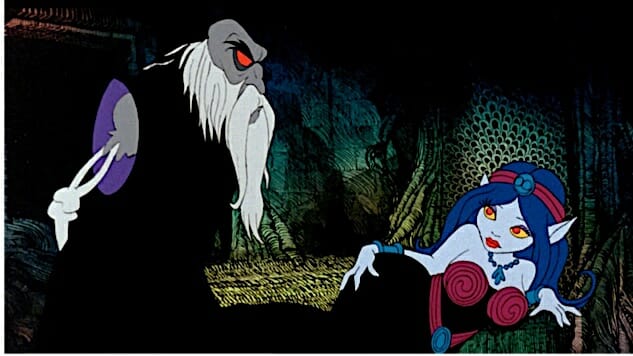
People are crummy, self-involved, ridiculous, horny and lovable, if you’re buying what cult classic animation legend Ralph Bakshi is selling.
Born in Palestine in 1938, his family fled to America to escape the Second World War. Growing up first in Brooklyn and then in the predominantly black Foggy Bottom neighborhood in Washington, D.C., Bakshi was a people watcher, and it shone through in the nine animated feature length films he directed between 1972 and 1992.
For a while, with Bakshi and Don Bluth making animated movies, it must have seemed like there would be a subversive alternative to the clean, sexless Disney canon. It didn’t last.
Bakshi’s films are pretty sleazy, but there’s an earnest humanity underneath the elastic dicks and impossible breasts. Nobody is above their baser impulses, but it does not mean they’re wholly horrible.
As his whacked out sci-fi fantasy epic Wizards turns 40, here’s a ranking of the nine animated feature films directed by the Jewish immigrant and New Yorker whose works acknowledge that the blood that pumps through a hero’s beating heart also makes its way to other throbbing organs and that’s okay.
9. Cool World (1992)
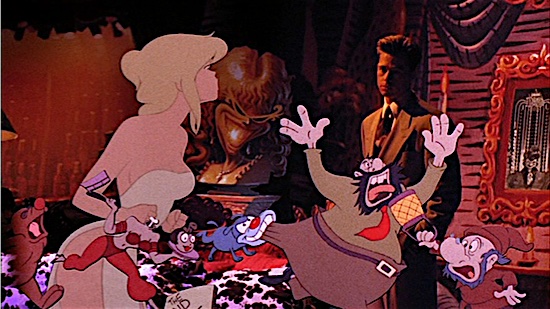
It’s unfortunate that the last director’s credit Bakshi got is also easily his least interesting film. Cool World raises way more questions than it ever answers, but here goes: Brad Pitt gets back from the Second World War, takes his mother on a motorcycle ride and gets into an accident that kills her. He’s dragged into the cartoon reality known as Cool World by a scientist on the other side. We rejoin him 50 years later as a cynical detective whose job is to prevent any humans (or “noids” as the movie insists on calling them) from entering Cool World and, for some reason, having sex with “doodles” (that is, cartoon persons).
For a film with such a complicated premise, there really isn’t a lot of explanation. Why can’t humans get down with toons? Why does Pitt stay young even though he’s still 100% human? The film has internal rules it doesn’t bother to explain and that wouldn’t make sense even if it did. It feels like 15 very important minutes ended up on the cutting room floor.
Everything Cool World does has been done better by other movies. It wants to be Who Framed Roger Rabbit? but, four years after it, puts far less effort into making it look as if humans and cartoons really are interacting in the same world. It wants to be Blade Runner but doesn’t invest any time in an intricate plot or a twisty investigation. Worst of all, it lacks any of the refreshingly batshit chaos that makes a Bakshi film something that must be seen to believed. Unlike the next entry on the list.
8. Coonskin (1975)
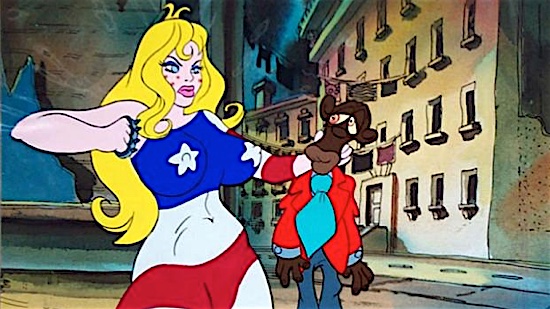
Yes, we need to talk about this one. Bakshi’s third time in the director’s chair uses the live-action framing device of a prison break in the deep American South, as two black escapees wait out a tense night by telling the animated tale of Brother Rabbit and his friends. Kicked out of his home and on the run from the law, Rabbit and his friends go to Harlem, where they experience the anger and upheaval of the post-Civil Rights era and climb to the top of the underworld ladder through violence and guile.
Bakshi immersed himself in black culture as a youth in Foggy Bottom. This is a weird love letter to that culture. Coonskin features caricatures of black people as uncomfortable as its title, but it also pits a group of black protagonists against a white man’s world and features Barry White and Scatman Crothers as voices. It must be said that it also treats every one of New York City’s minorities—from Jew to drag queen to Italian—with the same parodic unfriendliness. NYC wouldn’t even look this filthy and damned to perdition in Taxi Driver the following year.
Coonskin is provocative and subversive and terrifyingly relevant today, but it’s not that good. It does rate a view for a number of utterly unforgettable sequences: The country’s cruelty toward black people is characterized as a voluptuous and patriotically dressed blond amazon called “Miss America” who playfully titters “Rape!”, which instantly lynches a totally innocent musician. We’re treated to a short monologue from a black woman in Harlem, fighting despair as she tells stories of the shitty men in her life that characterize them as literal vermin. Brother Rabbit and the boys trick a corrupt and racist white cop into getting the goddamn hell ass shit shot out of him by his own colleagues.
You will feel deeply uncomfortable watching this movie. Unlike torture porn, though, this actually has something to say.
7. Hey Good Lookin’ (1982)
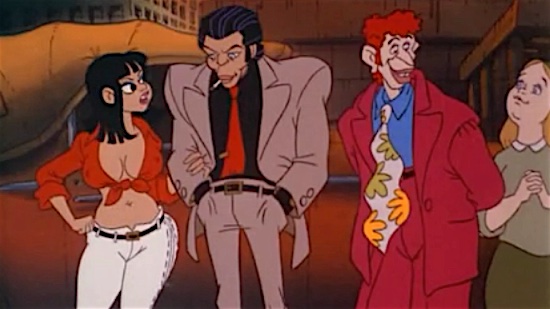
One of Bakshi’s most technically proficient and cleanly animated movies is also one of his most boring. Hey Good Lookin’ tells the story of greaser Vinnie, leader of a gang in Brooklyn called “The Stompers” in the 1950s. Vinnie falls in love with Roz and enjoys a few nights of foolish romance before his gang life catches up to him.
There isn’t a lot to tell here. There’s very little of the cartoon elasticity that makes other Bakshi movies unpredictable and deep. It’s hard to believe this was Bakshi’s followup to a later film that rates way higher on this list.
The one thing a viewer sick to death of Hollywood dreck can get out of this movie is its depiction of young romance. Amazingly, it acknowledges that a young, strutting guy who worries too much about his hair and a young, curvy lady who hangs out with her bestie and chafes at her father’s overprotectiveness would—gasp!—want to make out and have sex! It’s an order of magnitude more believable than Edward and Bella not screwing for four movies. Vinnie and Roz are horny young kids who are really into each other, and I’m sold.
Somebody sit Anakin and Padme or any damn action movie couple down and force them to watch this movie. It’d teach them how to be emotionally honest.
6. Heavy Traffic (1975)
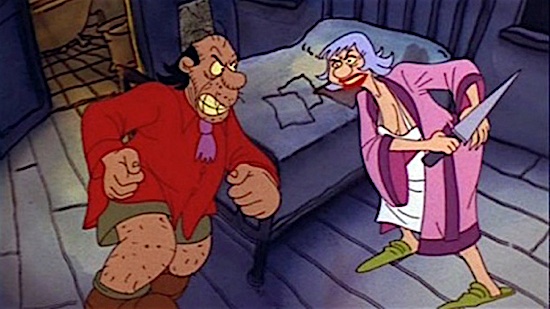
Bakshi goes semi-autobiographical in this tone poem of a film about a young aspiring cartoonist in New York City, born of a Jewish mother and an Italian father who harangue him about his love life and casually beat the crap out of each other.
This one is worth it for the feeling of peeking into an epoch from the view of a people watcher. The people Bakshi introduces us to are wild parodies of themselves: The drag queen who loves to trick drunk straight guys into a make-out session and get beaten around the bar, the young greasers who roughhouse so hard they’re stabbing one another with switchblades, a mob boss surrounded by nefarious cloaked demon priests who continues conducting business even after being shot full of bullets, and the old studio executive lying in a hospital bed bubble and hooked up to machines who is outright slain with shock when the young protagonist pitches a comic strip about post-apocalyptic deicide.
If you love children’s author Roald Dahl, you almost need to read his autobiography Boy. If you love you some Ralph Bakshi, you almost need to watch Heavy Traffic.
5. The Lord of the Rings (1978)
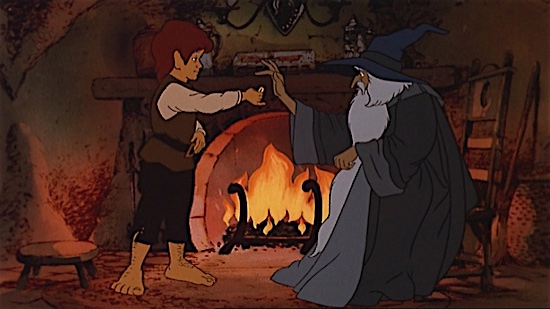
Oh, yes he did. Bakshi adapted Tolkien’s epic trilogy of high fantasy books long before Peter Jackson got his mitts on it, but the results are a bit questionable. Making heavy use of rotoscoping—the technique where live action is drawn over onto animation cels—Bakshi’s film tackles The Fellowship of the Ring and the first half of The Two Towers.
This film is as reverent a take as somebody like Bakshi could be expected to give the material. Working from a script by The Last Unicorn author Peter S. Beagle, it features the voice of John Hurt as Aragorn and Anthony Daniels—the skinny gentleman inside of C3PO—as Legolas. It also plays the material as straight and painfully earnest as anything you’ll ever see.
A devotee of the books, Bakshi was trying to talk people into the salability of an animated version of Tolkien’s magnum opus as early as 1957. Twenty years later, he managed to cut a deal to tell the whole trilogy in two films, and was serious enough about doing it right that he even consulted with Tolkien’s daughter.
While that approach was a hit with audiences, it bombed with critics, and we never got to see the conclusion. While it’s a lavish and interesting look at things like orcs and elves and the knockdown fight between Gandalf and the Balrog, it’s also sloppily cut and edited—dragging at some parts and giving viewers whiplash at others. It also doesn’t have any of the anarchic wildness of his other works.
It’s proof that Bakshi is at his best when he’s trampling all over the rules rather than following them.
4. Fritz the Cat (1972)
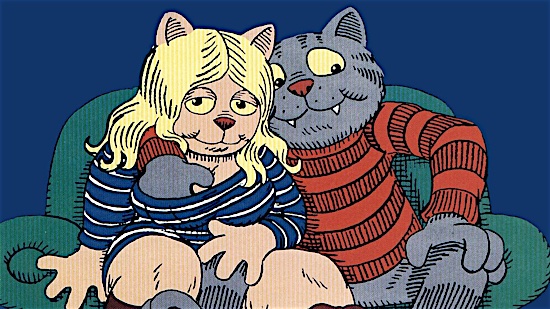
Is there anything more tiresome than unearned white Baby Boomer nostalgia for a time that actually sounds quite awful? Fritz the Cat is the rare treatment of the ’60s that acknowledges both the time period’s garden of delights for the bon vivant and how ridiculous and sometimes scornful it all was. People must have agreed with me in the wake of that period, because the movie stormed the box office even as it proudly paraded around its X rating.
The film casts the denizens of New York as anthropomorphic animals. Yes, all cops are pigs, and yes, all black people are crows, and no, you don’t need to be a mammal to have boobs.
Fritz is a callow young NYU student, dissatisfied with his privileged life and focused on living it up. That means using his rudimentary guitar skills and talent for slyly hamming up his existential ennui to pick up chicks in Central Park by day and ignoring the drug-fueled cram sessions of his university buddies to hit the town and get into trouble by night.
The film is more a series of incidents than a cohesive plot, and Fritz ends the film on the verge of a revelatory character turn—of becoming, as the kids say, “woke”—only to end the movie just the same way we meet him: A total cad.
But, for taking the ’60s and well-meaning progressivism down a peg, you just can’t beat it. At one point, a bunch of young women in the park surround a crow and go on about how stirred they are emotionally about the plight of black Americans, about how they’ve read every word of Baldwin, about how their hearts bleed over the mistreatment of his people. They probably just want to sleep with him. It is bitterly, alarmingly on point.
Then Fritz takes them to a party, gets them high as kites, and bangs them in the bathtub.
3. Wizards (1977)
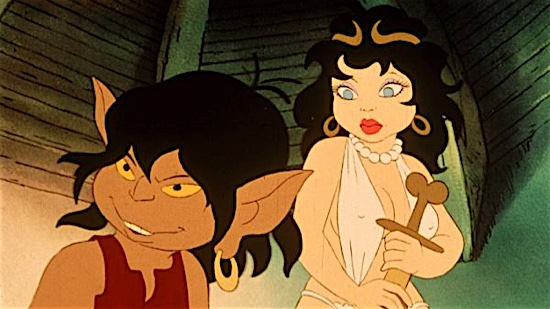
Now we’re talking.
Bakshi’s treatment of high fantasy in Lord of the Rings was lavish, but didn’t have anything original to say. But the year prior, his treatment of war through a fantasy lens was far less restrained, far more imaginative, and packed with little asides that poked at the absurdity of man’s destructiveness toward man and environment.
The movie tells the story of a post-nuclear apocalypse where irradiated mutants coexist uneasily with elves and fairies, and technology and magic war for dominance over the planet. It picks up centuries after twin wizards—the heroic Avatar and his power-hungry brother Blackwolf—clash in magical battle for dominion over the world. Avatar drives Blackwolf into the wastes, and he returns at the head of an army of mutants and actual demons from Hell to conquer the world with unearthed 20th century war machines and Nazi ideology. A washed up Avatar and his motley crew of young adventurers must journey to destroy Blackwolf’s secret weapon and stop his bloody campaign.
Wizards has quite a bit more ambition than it’s able to fulfill. Critical plot is sometimes handled through still images and narration—frankly, some of the most epic parts read as footnotes. But even that feels like Tolkien’s legendarium. And it also grounds the movie firmly in a sense of sorrow and exhaustion. The stooges filling the ranks of Blackwolf’s fascist army are a bunch of young dopes who want to wear uniforms and march around, even if it’s in service of pure evil. The leaders of the free world are feckless and easily assassinated, and the army that should stand against Blackwolf’s hordes is complacent.
Avatar trudges to battle, slouching under the feeling that he’s seen all this shit before. What must that feel like?
2. Fire and Ice (1983)

Just a year after Arnold Schwarzenegger stomped into theaters in 1982’s Conan the Barbarian, Bakshi’s Fire and Ice completely shows it up. A ruthlessly pure tale of pulp sword-and-sorcery adventure, it’s set in a prehistoric fantasy world where brutish Neanderthal-like humanoids fill out the ranks of the army of vicious sorcerer Necron—the ruler of an ice kingdom who seeks to swallow the world in glacial purgatory. He’s opposed by a volcanic fire kingdom that sends its warriors into battle on the backs of fucking pterodactyls. The story follows one young survivor of a village destroyed by Necron’s armies, a princess on the run, and a stoic barbarian in a loin cloth with a giant axe as they journey to defeat the sorcerer.
Fire and Ice is the best Dungeons & Dragons campaign your friend from high school never had time to finish writing because of finals. All the ladies are jiggly. All the men are beefcakes. Monsters and magic clash. There’s none of the jargon-y mumbo jumbo to get in the way of this heavy metal album cover of an action movie.
1. American Pop (1981)

I am one of the least receptive people to “let me show you my mixtape” movies. Yet, no other film can occupy #1 on this list.
Did you know your great grandfather? Will you know your great grandson? American Pop says no, but that doesn’t mean you don’t walk in their shoes, or that your triumph isn’t in some small way theirs as well.
I’ve complained before about there being so few looks at the immigrant experience in cinema recently. Bakshi’s 1981 animated feature is only about 95 minutes, but within that breezy timeframe it unspools an epic tale of four generations across the 20th Century American musical landscape, from Vaudeville and Cole Porter to rockabilly and The Mamas and the Papas. Zalmie is a young Russian Jew driven from his homeland and quickly orphaned in the New World. The film follows him through tragedy and war, through love and success—and then it moves on to his son and grandson as Zalmie turns stooly on the mob and, presumably, dies in jail. It isn’t that the film isn’t his story—it’s that it’s not just his.
His son, a talented piano player, dies at war to the romping tune of “Sing, Sing, Sing.” His grandson Tony wanders the country in existential pain as he writes songs for famous people to belt out but can’t get his own life together. But then, Tony’s illegitimate son Little Pete—whom Tony abandons after gifting him with the family harmonica and a massive bag of blow to sell—hits it big. The final ten minutes of the film are a feverish celebration of late ’70s music, of breaking the rules to get ahead, and of doing the Stray Cat Strut in general. Little Pete gets his big shot by threatening not to sell coke to a famous band unless they let him audition. They do, and he suddenly belts out “Night Moves” in Bob Seger’s voice despite the fact that he did not write “Night Moves” and he is not Bob Seger and it is bombastic and joyous and one of the few times Bakshi is 100 percent in earnest and nails it.
As Little Pete rocks the socks off a massive stadium of admirers, little images of his forefathers fleetingly fly by him. Little Pete never truly knew his father, never met his grandfather, probably never even heard of his great grandfather. He doesn’t know what they did to get him here, or what failings of theirs he has overcome despite the callousness of history. But we know that like the rich tapestry of music, it’s all really one story with a beginning we may never know and an ending we have yet to see.
Kenneth Lowe gets his dinner from a garbage can. He works as a public relations specialist in state government in Illinois and has been published in Illinois Issues, Colombia Reports and the St. Louis Post-Dispatch. Read more of his writings at gailybedight.com.